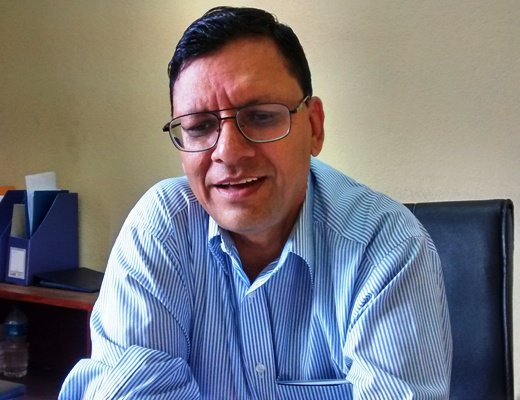
How do you look at the present state of development?
Development involves three aspects, political development, economic development and social development. Along with these, we also need to look at whether things are sustainable. When we say state of development, it covers all these equally important aspects.
As a civil servant, I cannot say much about the state of political development. However, the state of social and economic development is yet to post any major breakthrough. It is difficult to assess even the state of social development because the social scientists have their own views about it. Despite so many upheavals and instances of instability, Nepal has made a good progress in economic and social sectors. There will be debate over what good means. Nepal's economic growth is not bad as there are many countries around the world with worse economic status than Nepal. However, the average annual growth of four percent is not very satisfactory either. What I can say is that the growth rate is not everything, but growth rate is something very important. As Nepal is in the process of graduating from its LDC to developing status, the country needs to make over 8 percent of annual growth rate or at least record a double digit growth. Although Nepal's economic growth is increasing, the current growth is a low growth. Among the three dimensions, economy is the most important one.
How do you look at the challenges before Nepalese economy?
There are five problems in the Nepalese economy. Although our economy is increasing with a cumulative average of 4 and 4 and a half. This is low growth. Inflation is another problem. Although Nepal Rastra Bank's statistic shows that the inflation is in a single digit, it is no match to what the people are really facing. Our budget is in a deficit. Trade deficit is also gradually rising and it is becoming a chronic problem. Even the high flow of remittance is difficult to balance. The deficit is equal to annual budget deficit. Although the government is talking about the reform, the reform needs at the policy level not at the field level. Over the years, what I have been facing is the policy level problem. There is the need to have a policy to address issues emerging in the changing context. There is the need to take relevant reforms to make the policy updated and relevant. There is a problem in the continuity of our policy and work. Due to inconsistent policy, Nepal does not have the proper environment for Foreign Direct Investment. There may be many reasons. Despite the increase in the revenue generation, foreign aid contributes 30 percent in the total expenditure and 70 percent in development expenditure.
Having a long experience of working at the Foreign Aid Division, how do you view the recent trends in foreign aid?
The contribution of foreign aid in the total expenditure is around 30 percent. However, the total contribution in the development expenditure is seventy percent plus.
How do you rate Nepal's capacity?
Various programs have already been launched to improve the efficiency and capability of the person involved in implementation. It is gradually improving but it will take time. As the government and Nepal's development partners are concerned about capacity building, they will come out with something for this.
How do you look at the trends in loan and expenditure?
The loan trend is increasing as the Asian Development Bank and the World Bank have been there for a long period of time. Recently Exim Banks of India and China and other development banks and funds have come to provide loan. So far as grant is concerned, it is more or less stable. Ministry of Finance reports show that grant is more or less stagnant.
Although Nepal is receiving huge loans and grants, how do you view the level of expenditure?
Nepal's capability of using the money is very low. For instance, the availability of Asian Development Bank's commitment to Nepal is over 1.6 billion dollars over the years. However, we can take more money if we require. Forget about this, even ADB has been saying that Nepal needs to spend 250 million dollars this year. However, Nepal spent merely 30-35 million dollars in six months. This is same with the World Bank: the availability of fund is over 1 billion dollars and Nepal spending is in just two figures. Nepal needs to spend in three figures. Nepal is spending a very low foreign grant component also.
How can Nepal increase spending of available loan and grant?
So far as the spending capacity is concerned, it depends upon the vision of a particular individual. Nepal needs to have a vision to spend the money we are receiving under the grants and aids. Since I entered into the job, I have been listening to only one word from donors and government, that is, implementation.
It is often said that there is a problem in the implementation. How do you look at it?
I don't think there is any problem with implementation. I think only 10 percent of the projects run under the foreign aid suffer from implementation hassles. My experience is that large numbers of the projects suffered due to the ownership problem. As over 90 percent of the projects are designed by foreigners, there is virtually no involvement of Nepalese in the designing phase. Nepalese are involved only in the implementation stage. Thus, the persons involved in implementation phase show little interest. If you relate implementation with spending, I can see it covers only 10 percent.
What do you see is the problem then?
Particularly in foreign aid related projects, slow expenditure is related to the low involvement of Nepalese in the designing phase. What I can say is that over 90 percent of the projects are designed by foreigners.
Who do you blame for this?
We have to blame ourselves for this. In many cases, our implementing agencies show apathy at the designing phase. Personally, the concerned Nepalese are not serious in the design phase. Here comes the role of foreigners. We prefer to work only after the design stage. If we want to make effective use of foreign aid, we need to change this attitude. We must involve our officials from the very early phase of designing. Once Nepalese start getting involved in the design phase, they will commit themselves for implementation. If a person who designs the project gets involved in implementation, there will be improvement in implementation. Despite insistence from donors, we rarely show our interest in this. Officials are unaware where to go about doing things which we did not design or got us involved in the design stage. We are not serious.
How do you see the progress of the social sector?
Generally, the progress in social sector is at a satisfactory level as Nepal has drastically reduced the level of poverty. Nepal also achieved many goals and targets of Millennium Development Goals. Reports have shown that the remittances are a major reason behind the drastic reduction of poverty in Nepal. Despite making major progress in the social sector, we have yet to guarantee sustainability.
How do you view the need to have foreign aid?
Even the countries like India and China have been massively using the loan available from the World Bank and the Asian Development Bank to improve their infrastructure. We need to use the foreign aid to improve our infrastructure. In this interlinked world, Nepal needs foreign aid, knowledge aid and monetary aid to change the state of the country. Even countries like Malaysia, South Korea, Singapore and many developing countries took foreign aid in their early period of development. They came out from the need to use foreign aid within two twenty to twenty-five years. However, our problem is that we are yet to make any progress to exit from aid even after 6 decades.
Heading the Foreign Aid Division for a long time, how do you see the current Foreign Aid Policy?
This is a timely step. Since the first foreign aid policy was promulgated almost 14 years ago, there are a lot of changes that have happened now. There are shifts in global priorities and agenda. In this context, this is a very good step to have a new foreign aid policy now. This is necessary to increase aid effectiveness. At a time when Nepal's development partners and recipient country Nepal are expressing desire to make effective use of foreign aid, promulgation of new foreign aid policy is timely.
What is needed to enhance effectiveness of foreign aid?
As around 36 percent of foreign aid is still used out of budget frame, this has been creating a lot of problems. Making the provision to use the foreign aid in Nepal's priority sector, introduction of one window policy and asking Nepal's development partners to use foreign aid through national budgetary systems are good parts. Even during my tenure, we had made all efforts to bring aid within the national budget.
- MELAMCHI WATER SUPPLY: No Interruption During Monsoon
- Jun 25, 2025
- KOREAN RETURNEES: Successful Integration
- Jun 25, 2025
- UPPER TRISHULI-1: Engaging With Local
- Jun 25, 2025
- IME GROUP: Twenty Five Years Of Journey
- Jun 24, 2025
- NEPAL’S AIR POLLUTION: A Growing Health Concern
- Jun 24, 2025















